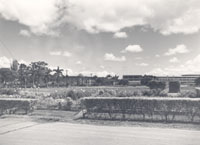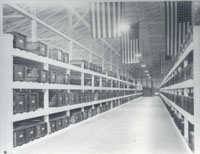In Her Words
"Operations at Central Identification Laboratory " by Mildred Trotter, 1949
Mildred Trotter wrote this report summarizing her work at the Central Identification Laboratory of the American Graves Registration Service in 1948-49. Trotter spent 14 months as the anthropologist at Schofield Barracks on Oahu, helping to identify the remains of American servicemen killed and buried in the Pacific Zone during World War II. This paper describes the process of identifying skeletal remains from both single and group burials, though Trotter later learned that this report had been "shelved." In the spring of 1949, she was asked to identify the commingled remains from the U.S.S. Arizona in Pearl Harbor. Trotter felt that segregation and individual identification of these remains was not possible; all the remains recovered from the Arizona were eventually interred in a common grave in the National Cemetery located in Punchbowl Crater.
OPERATIONS AT CENTRAL IDENTIFICATION LABORATORY, A.G.R.S
BY MILDRED TROTTER
World War II took the lives of approximately 350,000 Americans. Our government has undertaken to return the recoverable remains (approximately 300,000) to American soil, should such be the desire of the next of kin. If the next of kin wishes interment overseas, the remains are interred in American-owned cemeteries in Holland, England, France, Italy, Luxembourg, Tunis, the Philippine Islands, Hawaiian Islands, Alaska or Puerto Rico. When a remains is exhumed and positively identified the next of kin is notified and given a choice of disposition; either burial in a private cemetery or in a National Cemetery.
The responsibility of this entire undertaking has been assigned to the Department of Army under the direction of the Quartermaster General and is termed American Graves Registration Service.
Schofield Barracks, Oahu, ca. 1949
 |
There is involved: first, disinterment and delivery to a "Processing Station." These stations are located at Marbo on Saipan (one of the Marshall Islands), Manila in the Philippines, Japan and on Oahu for the Pacific Zone; at Fontainbleau (formerly at Strasbourg) and Carenton, France, and at Margraten near Maastricht in the Netherlands for the European Command; in Naples and Leghorn, Italy for the Mediterranean area and also, one in Cartage, North Africa. In addition, there is a mobile unit with headquarters just outside Paris.
At the "Processing Station," the identification of all remains is checked. More than 94 percent of the recovered remains have been positively identified. It must be emphasized that once official identification of a deceased has been made there can be absolutely no doubt as to the authenticity of that identification. In other words, remains are either positively identified or they are not - there is no tentative identification of remains which are about to be delivered to the next of kin.
If the remains is an identified one, the second step is to prepare it for burial in a "final type" casket, a beautiful (steel) one, with a bronzed finish which is hermetically sealed.
If the remains is an unidentified one, it is sent to the laboratory of the appropriate processing station for an anthropological examination. This involves the recording of as many physical data as are available, or as can be determined or estimated such as: race, sex, height, weight, age, a dental chart and occasionally even finger prints, as well as a reproduction of the identification tag ("dog"), serial or laundry marks on clothing, jewelry and numbered items of issued equipment.
Interior of mausoleum, Schofield Barracks
 |
At Schofield Barracks, two large connected buildings serve as mausoleums (numbers 1 and 2) where caskets from all parts of the Pacific are arranged in their original cemetery associations waiting examination and identification. Flags overhang the caskets and guards are on duty at all times. Other storage mausoleum areas are located at Wahiawa and Pearl Harbor; (the administrative Offices are at Fort Shafter).
A section of Mausoleum 1 serves as a visitors' lounge. This section is partitioned off into several small rooms where visitors may withdraw to spend time with the casketed remains or with the urn (if the body has been cremated), or where a funeral service may be held.
Main laboratory, CIL, Schofield Barracks
 |
Central Identification Laboratory, established in the fall of 1947, located in Mausoleum 2 at Schofield, is a light, airy and sanitary working area (a square room covering approximately 2000 sq. ft.) resembling in many respects a dissection room in a medical school. It is equipped with metal-covered tables (high and therefore comfortable for standing) and stools, fluorescent lights, sinks, a sterilizer, individual storage lockers, and operating room gowns. The wash-room is equipped with showers.
Certain group burials have been brought to us which were very large. In order to segregate the remains of this type of burial, it is essential to have all the remains "laid-out" at the same time. Thus, it was expedient to extend the laboratory until, now in addition, it covers approximately 9,000 more square feet. In the extension area, the tables are low and comfortable for sitting height. In adjacent rooms are offices for the army personnel and stenographers, a supply room, a fluoroscopic room, a photographic room and a coffee room.
The C.I.L. staff consists of the Army supervisors (one major and one captain), an anthropologist, licensed embalmers (there were 23 when I arrived last June), two dental technicians, a chemist, a photographer, an X-ray technician, several stenographers and typists, enough clerks for each pair of embalmers to have one available most of the time and a great number of laborers. The laboratory and both mausoleums are kept immaculate.
More then 99% of the remains which are brought to the C.I.L. are skeletal. In general, it may be said that they come under three categories: a single burial, a small group burial (2 - 15) and a large group burial (the largest at C.I.L. has been 434 which were recoverable remains from 2 common graves on the Island of Formosa).
Exterior of Central Identification Laboratory, Schofield Barracks, Oahu
 |
First, I shall describe what is involved in processing a single burial. The unknown is assigned to a pair of embalmers who lay the remains out on a sheet-covered table, the bones in anatomical arrangement. It may be necessary to brush the bones or sometimes even to wash them in order that definite criteria may be seen. At no time, however, are any soft parts, which might remain on the bones, removed. If the bones are broken, pieces are matched and held together with scotch tape, if possible. The remaining contents of the temporary casket are carefully examined (often fluoroscoped) for missing teeth, personal effects, I.D. tags, etc. The embalmers have been trained by the anthropologist, who is the roving consultant in the laboratory. (I haven't been able to get away from the student-teacher relationship.)
The bones are examined for evidence of healed fractures, mastoidectomy, pathology (arthritic lipping of vertebrae and of long bones), variations, such as torus palatinus, supracondyloid process, retroverted tibial heads, saber-shaped tibiae, third trochanter of the femur, squatting facets, wormian or sutural bones of the skull, perforation of olecranon fossa of sternum, etc.
The bones are then appraised for race: Pure racial strains are relatively easy and the skull gives the best evidence. Where the race is not pure, the various characters must be weighed.
Continued
1 | 2 | Next >>
Related Links:
|










